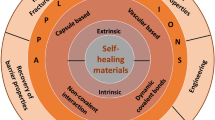Summary
The aim of the present study was to examine the suitability of biodegradable polymers as materials for a urethral stent. A new urethral stent made of biodegradable self-reinforced poly-l-lactide (SR-PLLA) was implanted in 16 male rabbits after urethrotomy. Seven stents of stainless steel served as controls. The dimensions of the two types of stents were identical: length 15 mm, diameter 8.2 mm. The mechanical construction was a helical spiral. The SR-PLLA spiral was sustained with three microspirals, and the whole device was coated withdl-lactide to achieve an active initial tissue reaction and better tissue penetration. The SR-PLLA stent showed more favourable implantation properties than the steel one. Within 6 months all PLLA stents had implanted, and the tissue reaction around the stent material was minimal. The helical spiral of stainless steel induced a remarkable inflammatory reaction due to poor implantation properties. We suggest that biodegradable SR-PLLA is a promising material for a urethral stent to prevent re-stenosis of urethral strictures.
Similar content being viewed by others
References
Ashken M, Coulange C, Milroy E, Sarramon J (1991) European experience with the urethral Wallstent for urethral strictures. Eur Urol 19:181
Holm-Nielsen A, Schultz A, Möller-Pedersen V (1991) Direct vision internal urethrotomy: a critical review of 365 operations. Er J Urol 56:308
Literature deleted
Milroy E, Cooper J, Wallsten H, Chapple R, Eldin A, Seddon A (1988) A new treatment for urethral strictures. Lancet I:1424
Newman LH, Stone NN, Chircus JH, Kramer HC (1990) Recurrent urethral stricture disease managed by clean intermittent self catheterization. J Urol 144:1142
Pitkämäki K, Tammela T, Kontturi M (1992) Recurrence of urethral stricture and late results after optical urethrotomy: comparison of strictures caused by toxic latex catheters and other causes. Scand J Urol Nephrol 26:327
Rokkanen P (1991) Absorbable materials in orthopedic surgery. Ann Med 23:109
Rousseau H, Puel J, Joffre F, Siegwart U, Duboucher C, Imbert C, Knight C, Kopf L, Wallsten H (1987) Self expanding endovascular prosthesis: an experimental study. Radiology 164:709
Ruutu M, Alfthan O, Strandensköld-Nordenstam CG, Lehtonen T (1983) Treatment of urethral stricture by urethroplasty or direct vision urethrotomy. Scand J Urol Nephrol 17:1
Sachse H (1974) Zur Behandlung der Harnröhrenstrictur: die transurethrale Schlitzung under Sicht mit scharfem Schnitt. Fortschr Med 92:12
Törmälä P (in press) Biodegradable self-reinforced composite materials: manufacturing structure and mechanical properties. Clin Materials
Author information
Authors and Affiliations
Rights and permissions
About this article
Cite this article
Kemppainen, E., Talja, M., Riihelä, M. et al. A bioresorbable urethral stent. Urol. Res. 21, 235–238 (1993). https://doi.org/10.1007/BF00590042
Received:
Accepted:
Issue Date:
DOI: https://doi.org/10.1007/BF00590042




